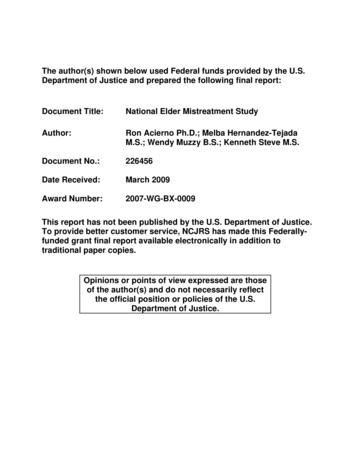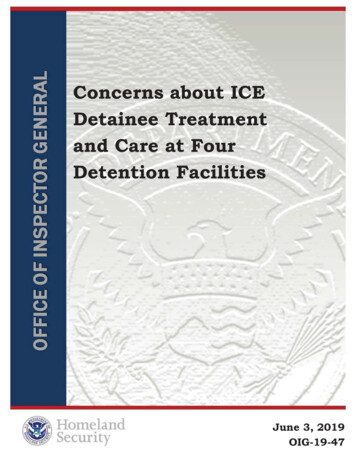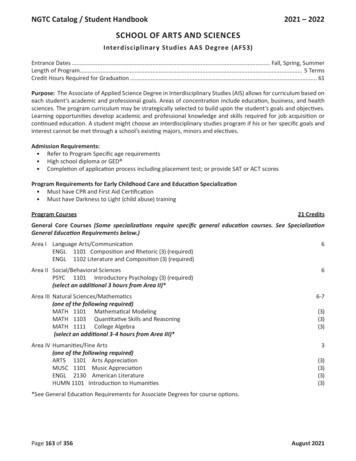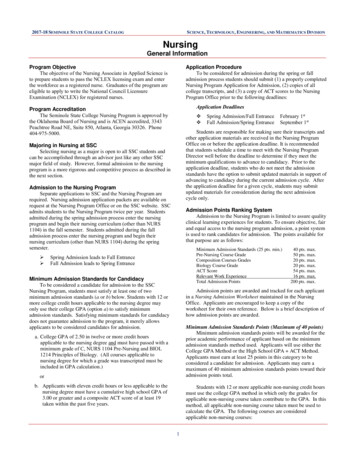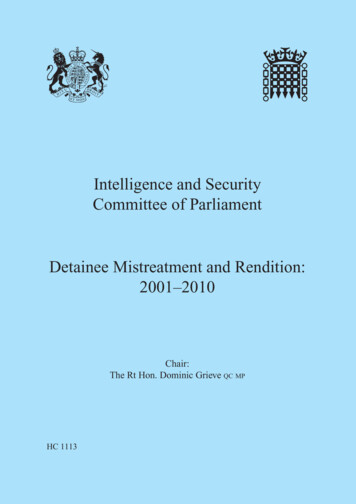
Transcription
Intelligence and SecurityCommittee of ParliamentDetainee Mistreatment and Rendition:2001–2010Chair:The Rt Hon. Dominic Grieve qc mpHc 1113
Intelligence and SecurityCommittee of ParliamentDetainee Mistreatment and Rendition:2001–2010Chair:The Rt Hon. Dominic Grieve qc mpPresented to Parliament pursuant to section 3of the Justice and Security Act 2013Ordered by the House of Commons to be printed28 June 2018HC 1113
Intelligence and Security Committee of Parliament copyright 2018The material must be acknowledged as Intelligence and Security Committee of Parliament copyrightand the document title specified. Where third party material has been identified, permission from therespective copyright holder must be sought.This publication is licensed under the terms of the Open Government Licence v3.0except where otherwise stated. To view this licence, icence/version/3Any enquiries regarding this publication should be sent to us via our webform atisc.independent.gov.uk/contactThis publication is also available on our website at: isc.independent.gov.ukISBN 978-1-5286-0475-8CCS051874648206/18Printed on paper containing 75% recycled fibre content minimumPrinted in the UK by the APS Group on behalf of the Controller of Her Majesty’s Stationery Office
THE INTELLIGENCE AND SECURITYCOMMITTEE OF PARLIAMENTThe Rt Hon. Dominic Grieve QC MP (Chair)*The Rt Hon. Richard Benyon MPThe Rt Hon. Ian Blackford MPThe Rt Hon. Caroline Flint MPThe Rt Hon. David Hanson MPThe Rt Hon. the Lord Janvrin GCB GCVO QSOThe Rt Hon. Kevan Jones MPThe Most Hon. the Rt Hon. the Marquess of Lothian QCThe Rt Hon. Keith Simpson MPThe Intelligence and Security Committee of Parliament (ISC) is a statutory committee ofParliament that has responsibility for oversight of the UK intelligence community. TheCommittee was originally established by the Intelligence Services Act 1994, and has recentlybeen reformed, and its powers reinforced, by the Justice and Security Act 2013.The Committee oversees the intelligence and security activities of the UK, including thepolicies, expenditure, administration and operations of the Security Service (MI5), the SecretIntelligence Service (SIS) and the Government Communications Headquarters (GCHQ).† TheCommittee also scrutinises the work of other parts of the UK intelligence community, includingthe Joint Intelligence Organisation and the National Security Secretariat in the Cabinet Office;Defence Intelligence in the Ministry of Defence; and the Office for Security and CounterTerrorism in the Home Office.The Committee consists of nine Members drawn from both Houses of Parliament. The Chairis elected by its Members. The Members of the Committee are subject to section 1(1)(b) ofthe Official Secrets Act 1989 and are routinely given access to highly classified material incarrying out their duties.The Committee sets its own agenda and work programme. It takes evidence from GovernmentMinisters, the Heads of the Security and Intelligence Agencies, officials from the intelligencecommunity and other witnesses as required. The Committee is supported in its work by aSecretariat. It also has access to legal, technical and financial expertise where necessary.The Committee makes an annual report to Parliament on the discharge of its functions. TheCommittee may also produce reports on specific investigations. Prior to the Committeepublishing its reports, sensitive material that would damage national security is blanked out(‘redacted’). This is indicated by *** in the text. The Security and Intelligence Agencies mayrequest the redaction of material in a report if its publication would damage their work, forexample by revealing their targets, methods, sources or operational capabilities. The Committeeconsiders these requests for redaction carefully. The Agencies have to demonstrate clearlyhow publication of the material in question would be damaging before the Committee agreesto redact it. The Committee aims to ensure that only the minimum of text is redacted froma report. The Committee believes that it is important that Parliament and the public should* This Report reflects work largely undertaken by the previous Committee, which sat from September 2015 to May 2017, thoughit was initiated by the Committee chaired by the Right Hon. Sir Malcolm Rifkind, which sat from October 2010 to March 2015.Membership of the 2015–17 Committee included the Right Hon. Angus Robertson, the Right Hon. Gisela Stuart and (until July2016) the Right Hon. Sir Alan Duncan kcmg mp. Membership of the 2010–15 Committee at the time it initiated the Inquiry includedthe Right Hon. Hazel Blears, the Right Hon. the Lord Butler of Brockwell kg gcb cvo, the Right Hon. the Lord Campbell ofPittenweem ch cbe qc, the Right Hon. Mark Field mp, and the Right Hon. Dr Julian Lewis mp. The Right Hon. Fiona Mactaggart(from May 2014) and the Right Hon. George Howarth mp (until October 2016) were members of both predecessor Committees.† The Committee oversees operations subject to the criteria set out in section 2 of the Justice and Security Act 2013.iii
Detainee Mistreatment and Rendition: 2001–2010be able to see where information had to be redacted. This means that the published reportis the same as the classified version sent to the Prime Minister (albeit with redactions). TheCommittee also prepares from time to time wholly confidential reports which it submits to thePrime Minister.iv
CONTENTSEXECUTIVE SUMMARY 11. THE INQUIRY 7The Report 102. THE LEGAL FRAMEWORK 13Legal obligations 13Definitions 143. THE SCALE OF INVOLVEMENT WITH DETAINEES 17Deployment of SIS and MI5 officers 17Deployment of GCHQ officers 18Deployment of MOD personnel 19Head Offices 204. DIRECT INVOLVEMENT IN MISTREATMENT 21Allegations of torture by British officials 22Threatening behaviour 23Direct involvement in mistreatment administered by others 255. AWARENESS OF MISTREATMENT 29Head Office knowledge at the outset: 2001 29Deployed personnel awareness: 2002–2004 31Head Office realisation: 2002–2004 446. ACTION WHICH MAY HAVE LED INDIRECTLY TO MISTREATMENT 51Passing and receiving information and intelligence 51Turning a blind eye in the interests of the broader relationship 577. HMG RESPONSE 61Supporting staff: initial guidance and training 61Briefing Ministers, 2001–2003 66A turning point? 69Guidance and training, 2004–2010 72Briefing Ministers, 2004–2010 75Adequacy of HMG response, 2004–2010 798. INVOLVEMENT IN RENDITION 83The US rendition programme 83UK involvement in renditions 87HMG response 1089. KEY CONCERNS 115v
Detainee Mistreatment and Rendition: 2001–2010ANNEXESA: FULL LIST OF CONCLUSIONS 117B: INQUIRY TIMELINE 121C: ISC LETTER TO THE PRIME MINISTER ABOUT BINYAM MOHAMED 123D: FCO OVERSIGHT OF ACTIVITY ON DIEGO GARCIA 139E: CODE WORDS 141F: GLOSSARY 145G: WITNESSES AND CONTRIBUTORS 151Most commonly used TSISUKUSAUNCentral Intelligence AgencyCruel, inhuman or degrading treatmentForeign and Commonwealth OfficeGovernment Communications HeadquartersHer Majesty’s GovernmentHuman-sourced intelligenceThe Security ServiceMinistry of Defence(US) National Security AgencySignals intelligenceSecret Intelligence Service (MI6)United Kingdom–United States Communication Intelligence AgreementUnited NationsUse of code wordsThroughout this Report, the names of detainees, geographic identifiers (such as nationality)and a small number of staff and operational names have been substituted for our owncode words in order to protect classified information. Code words replacing geographicindicators have not been used consistently throughout the Report for the same reason. Listsare provided in Annex E.vi
EXECUTIVE SUMMARYImmediately following 9/11, there were real concerns that Al Qaida may have been planninga terrorist attack on the UK of similar magnitude. Disrupting such an attack was the UKSecurity and Intelligence Agencies’ absolute operational imperative, and assisting the US ininterviews of US-held detainees might give the UK Agencies access to critical intelligence.Throughout 2002, 2003 and into 2004, UK personnel from SIS, MI5 and MOD – includingthe Armed Forces – participated in interviews of detainees held (primarily) by US detainingauthorities at locations in Afghanistan and Iraq, and at Guantanamo Bay. Neither the Agenciesnor Defence Intelligence were the detaining authorities at any point. Sometimes the deployedpersonnel conducted their own interviews, sometimes they interviewed jointly with USinterrogators and sometimes they simply observed interviews conducted by others (or passedquestions to those interviewing). It is not possible to determine the exact number of detaineeinterviews in which UK personnel were involved, but we estimate it to be somewhere between2,000 and 3,000.This Report details the findings of the Intelligence and Security Committee’s Inquiry intothe actions of the UK Agencies and Defence Intelligence in respect of detainees and alsorendition. We have taken 50 hours of oral evidence, reviewed 30,000 original documents anda further 10,000 documents which we requested, and 30,000 staff hours have been devoted tothis Inquiry. We are very grateful to some of the former detainees for talking to us, and to threeformer members of staff who came forward of their own volition to act as witnesses.We reached the point in our Inquiry where we had covered the breadth of the issues but neededto examine certain matters in detail, which could only be done by taking evidence from thosewho had been on the ground at the time. We have been denied that access. Restrictions wereimposed by the Prime Minister on grounds of seniority and involvement in proceedings whichreduced our list of potential witnesses to just four. Furthermore, even those individuals wouldnot be allowed to give evidence on specific cases.The Committee was adamant that if the Inquiry was to be thorough and be in a positionto reach properly considered and fair views about the facts, then we must hear from thoseofficers who were involved at the time. The terms and conditions imposed were such thatwe would be unable to conduct an authoritative Inquiry and produce a credible Report. TheCommittee has therefore concluded – reluctantly – that it must draw a line under the Inquiry.This is regrettable.Nevertheless, we believe that the Inquiry had – up to the point we were able to take it –progressed matters significantly. Crucially, we had uncovered new material which had notbeen presented to any previous inquiry or review – including that begun by Sir Peter Gibson.The Committee has therefore decided that what we have found to date must be put into thepublic domain, as the next step towards transparency and an understanding of what took place.This Report seeks to do just that. It is not, and must not be taken to be, a definitive account.Where possible, we give a figure for the total number of cases that we are aware of for each ofthe areas of concern. These numbers rely on the documentary evidence we have seen, and ourinterpretation of that evidence. However, formal records are lacking for at least some of theperiod of concern; this lack of a comprehensive and reliable evidence base makes definitivefigures impossible. Any conclusions drawn are necessarily provisional; had the further witness1
Detainee Mistreatment and Rendition: 2001–2010evidence we sought been made available to us, and had we therefore continued the Inquirybeyond this point, we may have differently categorised some of the cases of concern, and takena different standpoint. This Report is therefore our account of what we have been able to findto date, and in some cases an indication of what we believe necessitates further exploration.Key findingsIn relation to direct involvement in mistreatment by UK personnel: From our examination of the primary material and our questioning of witnesses, at thepoint at which we concluded our Inquiry we had not found any evidence indicating thatUK Agency officers or Defence Intelligence personnel directly carried out physicalmistreatment of detainees.We have, however, to date, found evidence of UK officers making verbal threats in ninecases. Whilst it is clear that such threats are unacceptable, the making of threats is notproperly identified as prohibited in guidance available today. This should be rectified.We have also found what we consider to constitute evidence of two cases in which UKpersonnel were directly involved in detainee mistreatment administered by others. Thisis completely unacceptable. While one case has been investigated by the MetropolitanPolice, the other has not been fully investigated. Had our Inquiry continued, we wouldhave sought to interview all those concerned. There must be a question as to whether theService Police investigation should be reopened.1In relation to awareness of mistreatment: 1Immediately after 9/11, senior Agency staff were briefed by the US Agencies; in ouropinion these briefings clearly showed US intent and should have been taken seriously.It was mistaken to dismiss them. The Agencies (and broader HMG) had a clear warningand, while they may have considered it rhetoric at the time, it should have been sufficientto alert them to any subsequent indication that words were being matched by actions.We have found 13 incidents recorded where it appears that UK personnel witnessed atfirst hand a detainee being mistreated by others – such that it must have caused alarm andshould have led to action.From the primary material, we have found 25 incidents recorded where UK personnelwere told by detainees that they had been mistreated by others. The Agencies had aresponsibility to investigate such claims before continuing to engage with the detaineeconcerned. We have seen in a number of cases that they did so; however, this wasnot consistent.We have also found 128 incidents recorded where Agency officers were told by foreignliaison services (whether formally or informally) about instances of what appears to bedetainee mistreatment.The ‘Service Police’ is the term used for the police forces of the Army, Royal Navy and Royal Air Force.2
Executive summaryIn relation to sharing of intelligence: Post 9/11, the Agencies shared an unprecedented amount of intelligence with foreignliaison services to facilitate the capture of detainees. The Agencies failed to considerwhether it was appropriate to pass intelligence where mistreatment of detainees wasknown or reasonably suspected. From the primary material, we have found 232 casesrecorded where it appears that UK personnel continued to supply questions or intelligenceto liaison services after they knew or suspected (or, in our view, should have suspected)that a detainee had been or was being mistreated.We have also found 198 cases recorded where UK personnel received intelligence fromliaison services obtained from detainees whom they knew had been mistreated, or withno indication as to how the detainee had been treated but where, in our view, they shouldhave suspected mistreatment.2Our Report also outlines our concerns in relation to the lack of guidance to officers (weconsider those staff deployed to have been left worryingly under-supported by their HeadOffices) and the failure of the Agencies to brief their Ministers.In relation to rendition: There were early indications of the US’s more aggressive approach to rendition; however,the Agencies persisted in viewing cases as ‘isolated incidents’. There was therefore noco-ordinated attempt to identify the risks involved and formulate the UK’s response: legaladvice across Departments and the Agencies regarding rendition was confused and poorlydisseminated from the outset. There was no understanding in HMG as to what was meantby the term ‘rendition’, and no clear policy (or even recognition of the need for one).The one aspect of UK policy which was clear was that the UK does not conduct renditionoperations itself. However, in three individual cases SIS or MI5 made, or offered tomake, a financial contribution to others to conduct a rendition operation. Given that theoperations were to countries such as LEEDS and DORNOCH, these can be described as‘extraordinary renditions’ due to the real risk of torture or cruel, inhuman or degradingtreatment of the detainees. The Agencies’ financing of these operations was completelyunacceptable. In our view this amounts to simple outsourcing of action they knew theywere not allowed to undertake themselves.The Agencies also suggested, planned or agreed to rendition operations proposed by othersin 28 cases. We have seen a further 22 cases where SIS or MI5 provided intelligenceto enable a rendition operation to take place; and 23 cases where they failed to takeaction to prevent a rendition – this latter category includes instances where there wereopportunities to intervene and prevent the rendition of a British national or resident, butthe UK Government conspicuously failed to act.Numbers of cases include only those where a named individual is identified in the records. An individual case may fall into morethan one of the categories of concern considered in this Report. We have reviewed 863 named cases that appear in the documentsdisclosed to us.23
Detainee Mistreatment and Rendition: 2001–2010 There is, however, no evidence in the primary material that any US rendition flighttransited the UK with a detainee on board, although two detainees are now known to havetransited through the British Overseas Territory of Diego Garcia. The Committee has seennothing to indicate that detainees have ever been held on Diego Garcia. We note, however,that the policy on recording flights was woefully inadequate, and the records available arepatchy and cannot be relied on.Did the Agencies turn a blind eye?From the evidence we have seen and heard, it is undeniable that the UK Agencies at HeadOffice level were aware of reports that some detainees held by the US had been mistreated.There are 38 cases in 2002 alone of officers witnessing or hearing about mistreatment(that we have found up until this point in our Inquiry). The Agencies argue that thesewere ‘isolated incidents’. They may have been isolated incidents to an individual officer.However, the 38 cases reported to Head Office cannot be considered ‘isolated’ whentaken together.The Committee understands that the pace of work in the months following 11 September2001, both in Afghanistan and London, was frenetic, placing both Field Officers and HeadOffices under significant pressure, and that the priority was to prevent another attack on thescale of 9/11. Nevertheless, the combination of high-level briefing from the CIA in September2001, the individual cases of mistreatment and rendition being reported by deployed officersto senior managers in January 2002, and the media reporting of torture, mistreatment andrendition in January/February 2002, make it difficult to comprehend how those at the top ofthe office did not recognise in this period the pattern of mistreatment by the US.While 2004 onwards finally saw the Agencies joining the dots, and this led to anincrease in policy discussions and guidance and training, a genuine understanding of thesituation – and therefore the seriousness of the position in which the UK had founditself – was still slow to dawn. There continued to be examples of failures to follow the evolvingguidance over subsequent years.This could indicate that the Agencies were deliberately turning a blind eye so as not to damagethe relationship and risk the flow of intelligence; if the Agencies started raising concerns,the US could have refused UK officers access to the detainees and stopped passing on anyintelligence they obtained. Given that detainees were a significant source of informationregarding any possible attacks against the UK, this would have represented a significant lossof potentially vital intelligence.The Agencies say that they were not reluctant in principle to raise mistreatment with the USauthorities. In our view, the evidence instead suggests a difficult balancing act: the Agencieswere the junior partner with limited access or influence, and distinctly uncomfortable at theprospect of complaining to their host.That being said, we have found no ‘smoking gun’ in the primary material to indicate that theAgencies deliberately overlooked reports of mistreatment and rendition by the US as a matterof institutional policy.4
Executive summaryDid the Agencies act reasonably?We do not underestimate the pressure that the Agencies experienced whilst dealing with theoperational imperative to protect the UK. However, they lacked the experience and trainingnecessary in the complex situations that deployed staff faced in dealing with detainees inAfghanistan, Iraq, Guantanamo and elsewhere. They also lacked a proper understanding ofwhat constituted mistreatment and what to do when they encountered it. As a result, they werefar too slow to recognise what was clearly happening and tolerated actions, and took others,that we regard as inexcusable.We do not deny that it is easy to criticise with the benefit of hindsight, and do not seek to blameindividual officers acting under immense pressure. Our Inquiry has, however, revealed seriousconcerns, outlined in the 27 conclusions contained in the body of this Report.5
1. THE INQUIRY1. On 12 September 2001, the Prime Minister telephoned the US President to offer the UK’sassistance in the aftermath of the 9/11 attacks.3 In December 2001, this offer was taken up: theUS requested specific assistance from SIS and MI5 with the screening of Al Qaida detainees,because their shortage of Arabic speakers was hampering progress.42. The ‘special relationship’ between the US and UK meant that this sort of co-operationwas not unusual, and the UK Security and Intelligence Agencies had the global reach and therequisite language capabilities. SIS explained that:there was a real imperative to support the United States, a reflex I would go sofar as to say, an unconditional reflex to support the United States, which wasclear and came from the political centre. What we had and we’re widely knownfor is our cultural and linguistic expertise. So particularly Arabic speakers, highquality staff, people also who are linked back to UK databases. So we had a bigcontribution to make and it’s inevitable that we quickly got drawn into the middleof this.53. This request for help was also seen by HMG as an opportunity: there were real concernsthat Al Qaida may have been planning a terrorist attack on the UK of similar magnitude to 9/11,and assisting in interviewing US detainees would give the UK Agencies access to intelligencewhich might counter that threat. SIS told us that:there was a real expectation that there was another attack coming down thetrack, and in particular an expectation that the United Kingdom would be in thenext wave of targets. So the overriding imperative was of course to try to disruptwhatever it was that was coming next, and that was the dominant theme at thetime. Now, intelligence on the threat was difficult to obtain. We didn’t havemany sources. Counter-terrorism had not been a priority for us prior to 9/11 andwe didn’t have many sources. So detainees were an obvious potential source ofinformation against this urgent requirement. The US held most of the detainees.64. Throughout 2002, 2003 and into 2004, UK personnel from SIS, MI5 and MOD – includingthe Armed Forces – participated in interviews of detainees held (primarily) by US detainingauthorities at locations in Afghanistan and Iraq, and at Guantanamo Bay.7 UK personnelconducted their own interviews of detainees, they conducted interviews jointly with USinterrogators, and they observed interviews conducted by others. It is not possible to determinethe exact number of detainee interviews in which UK personnel were involved, but it is in thelow thousands.5. Concerns over the treatment of detainees in US detention facilities surfaced shortly after theinitial deployment of Agency personnel to Afghanistan. The Washington Post first criticised theClassified SIS report (2014) responding to the issues raised in: Sir Peter Gibson, ‘The Report of the Detainee Inquiry’ (closedversion) (2013).4SIS message from CARLISLE Station to SIS Head Office, KIRKWALL Station, an overseas posted unit, and MI5 headquarters,30 December 2001.5Oral evidence – SIS, 3 December 2015.6Ibid.7Defence Intelligence did not participate in interviews of detainees at Guantanamo Bay.37
Detainee Mistreatment and Rendition: 2001–2010conditions at Guantanamo Bay on 11 January 2002.8 Allegations of mistreatment, principallyby the US, continued to emerge on a regular basis in the media and through the United Nationsand human rights non-governmental organisations (NGOs) such as Amnesty International,Liberty and Reprieve. Ministers were asked questions in Parliament and by the beginning of2004 matters escalated quickly: in January, the Intelligence and Security Committee (ISC)wrote to the Prime Minister asking for an explanation of the Agencies’ participation in detaineeinterviews; in March, a report by the International Committee of the Red Cross was leakedwhich contained details about US mistreatment of prisoners; and then in April, the story ofabuse at Abu Ghraib by US military personnel became public.6. A number of inquiries were held from 2004 onwards, but allegations of mistreatmentcontinued and by 2009 cases were being brought against the Government alleging complicityby the UK in the mistreatment of detainees. As a result, on 6 July 2010, the Prime Ministermade a statement to Parliament setting out how the Government intended to “clear up thismatter once and for all how we will deal with the problems of the past, how we will sort outthe future and how we can make sure that the security services are able to get on and dotheir job to keep us safe.”9 One of the measures intended to achieve this was an independentInquiry to “examine whether, and if so to what extent, the UK Government and its intelligenceagencies were involved in improper treatment of detainees held by other countries in counterterrorism operations overseas, or were aware of improper treatment of detainees in operationsin which the UK was involved.”107. Sir Peter Gibson, who was appointed to chair the Inquiry, began work with his panelin July 2011.11 However, Sir Peter was unable to begin taking evidence while MetropolitanPolice inve
SIS Secret Intelligence Service (MI6) UKUSA United Kingdom–United States Communication Intelligence Agreement UN United Nations Use of code words Throughout this Report, the names of detainees, geographic identifiers (such as nationality) and a small number of staf
